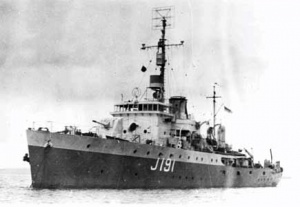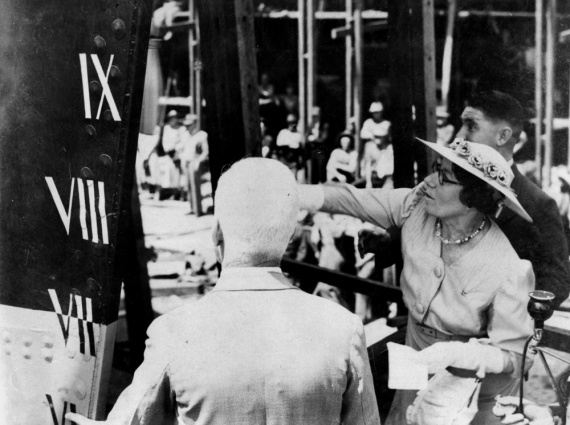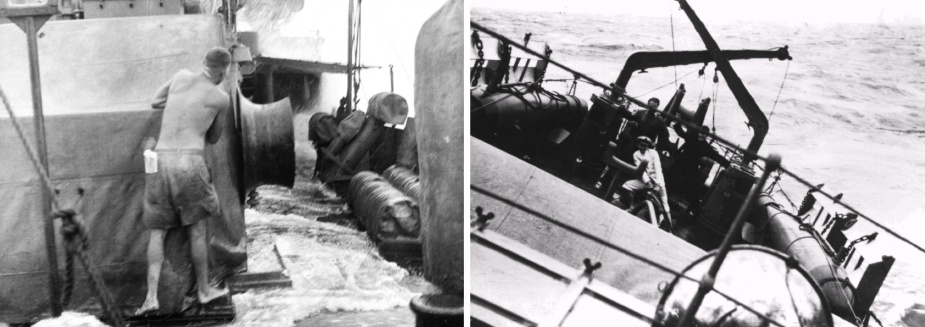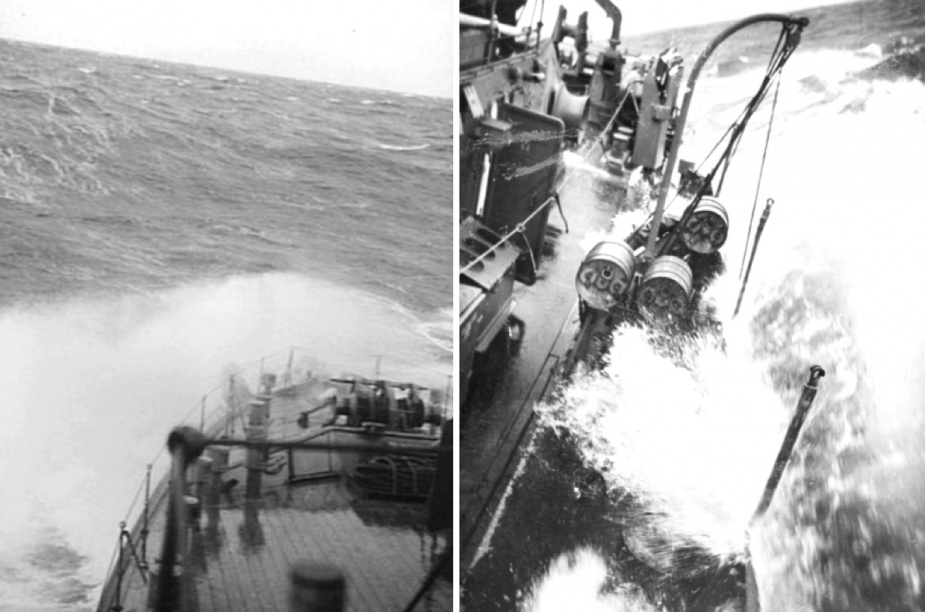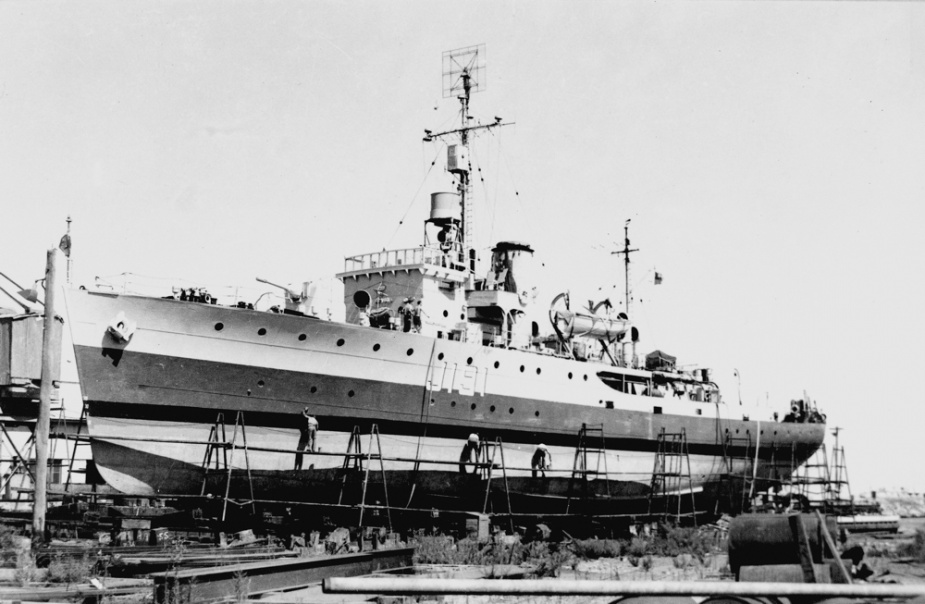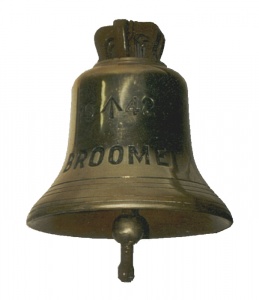HMAS Broome (I)
| Class |
Bathurst Class |
|---|---|
| Type |
Australian Minesweeper |
| Pennant |
J191 |
| Builder |
Evans Deakin & Co Ltd, Brisbane |
| Laid Down |
3 May 1941 |
| Launched |
6 October 1941 |
| Launched by |
Mrs McKew, wife of the Works Manager, Evans Deakin & Co Ltd |
| Commissioned |
29 July 1942 |
| Decommissioned |
April 1946 |
| Fate |
Recommissioned into the Royal Navy, mid-April 1946 |
| Dimensions & Displacement | |
| Displacement | 650 tons |
| Length | 186 feet 2 inches |
| Beam | 31 feet |
| Draught | 8 feet 6 inches |
| Performance | |
| Speed | 15 knots |
| Complement | |
| Crew | 85 |
| Propulsion | |
| Machinery | Triple expansion, 2 shafts |
| Horsepower | 2000 |
| Armament | |
| Guns |
|
| Other Armament |
|
| Awards | |
| Battle Honours | |

HMAS Broome was one of sixty Australian Minesweepers (commonly known as corvettes) built during World War II in Australian shipyards as part of the Commonwealth Government’s wartime shipbuilding programme. Twenty (including Broome) were built on Admiralty order but manned and commissioned by the Royal Australian Navy. Thirty six were built for the Royal Australian Navy and four for the Royal Indian Navy.
HMAS Broome was laid down at Evans, Deakin & Co Ltd, Brisbane, Queensland on 3 May 1941. She was launched on 6 October 1941 by Mrs MJ McKew, the wife of the ship builder's works manager and was the first RAN warship to carry the name of the coastal, pearling and tourist town in the Kimberley region of Western Australia, 2240 kilometres north of Perth.
Broome commissioned at Brisbane on 29 July 1942 under the command of Lieutenant Commander RA Denovan RANVR, but remained in the builder’s hands until accepted by the Royal Australian Navy on 19 August 1942. On 25 August she sailed for Sydney to complete fitting out.
Broome commenced her operational service on 19 October 1942 when she joined a Sydney to Brisbane convoy off Newcastle. She parted from the convoy off Moreton Bay and proceeded to Townsville and then to Cairns. Until mid-November 1942 the ship was engaged on anti-submarine patrols and escort duties in the North Queensland area, when she transferred to New Guinea waters for similar work in the Port Moresby and Milne Bay areas.
In December 1942 Broome and her sister ships Ballarat and Colac were detailed to transport Australian troops and land them as far forward as possible in the Buna area. The three vessels reached the landing point at Cape Sudest near Oro Bay without incident, but a few minutes later unidentified aircraft began dropping flares. Because of the threat of attack from enemy aircraft and from enemy warships believed to be in the area it was decided to retire temporarily after only 46 men had disembarked out of a total of 762. Later the same day (14 December) the operation was successfully completed using a new landing position and under cover of darkness all troops were put safely ashore.
In January 1943 Broome returned to Australia where she spent a month based on Townsville before resuming escort duties. From 8 February 1943, when she sailed from Townsville for Port Moresby, until mid-May, she was constantly in service escorting convoys between Townsville and Milne Bay. Japanese submarines were very active in Australian waters during this period and merchant ships were sunk but neither Broome nor any of the ships in her convoys were attacked.
On 26 May 1943, Broome returned to Sydney after an absence of seven months on operational service. Following a major refit she was assigned, in July 1943, to duty as an escort vessel on the east coast of Australia, mainly between Sydney and Brisbane. In December 1943 she resumed escort of convoys proceeding between Queensland ports and Milne Bay, a duty which kept her busy for most of the first half of 1944. From June to December 1944 Broome was assigned to New Guinea waters for escort and patrol work operating as far north as Morotai Island in the Halmaheras. This period witnessed the final defeat of the Japanese in New Guinea and except for mopping up operations, the end of the Allied campaign in that theatre of war.
In January 1945 Broome returned to Australia for refit and then, after further service in New Guinea in the Mios Woendi, Noemfoor and Morotai area, proceeded to Darwin in late March 1945 where she joined the Royal Australian Navy Survey Group. After a month on survey duties in the Darwin area she proceeded to Fremantle, then to Adelaide for refit, and finally to Sydney at the close of June 1945. Her arrival there completed Broome’s circumnavigation of Australia. She had steamed 96,000 miles since commissioning.
In July 1945 Broome again returned to New Guinea for further escort and anti-submarine patrol duties. Shortly before the end of hostilities she visited Morotai, Borneo and the Philippines. When hostilities ceased on 15 August 1945 the ship was at sea on escort duty, en route from Zamboanga in the Philippines to Morotai.
After returning to the Philippines Broome commenced preparations for mine-sweeping duty in Hong Kong, where she arrived on 30 August. In company with the ships of the Royal Australian Navy Mine-sweeping Flotillas, she carried out clearance sweeps, survey duties and anti-piracy patrols. Returning to Morotai on 17 October 1945, she was subsequently engaged in ferrying troops and stores in the Moluccas and searching the islands of Banda, Toeal and Kai for signs of missing aircraft.
On 29 December 1945 arrived at Darwin and sailed three days later for her namesake town, which she visited on 4 and 5 January 1946. On 10 January she arrived at Fremantle, bringing her wartime service to a close. She had steamed 109,869 miles.
In mid-April 1946 Broome was paid off and recommissioned into the Royal Navy. On 8 May 1946 the ship sailed from Fremantle for Colombo en route to Istanbul where she arrived on 22 August 1946. Two days later she was officially handed over to the Turkish Navy and renamed Alanya. Alanya was classified as a corvette (logistic support ship). ‘Jane’s Fighting Ships’ reported that Alanya was deleted from the Turkish Navy in 1975.
Broome’s ship’s bell was removed as a relic before transfer to Turkey. The bell was landed at Broome from HMAS Mildura on 20 May 1952 and presented to the Broome Road Board by His Excellency the Governor of Western Australia on 29 June 1952. The Board presented the bell to the Broome State School on 7 November 1952. It now hangs at the Returned Servicemen's Club in Broome.
Note: This video is hosted on YouTube. Department of Defence users will not be able to view this video on the Defence Protected Network.
This cine film has been placed online as part of the Sea Power Centre - Australia's ongoing archival digitisation program.
Further reading
- 'The Corvettes: Forgotten Ships of the Royal Australian Navy' by Iris Nesdale - published by the author, October, 1982.
- 'Corvettes - Little Ships for Big Men' by Frank B Walker - published by Kingfisher Press, NSW, 1996.
- 'The Australian Centenary History of Defence Volume III, The Royal Australian Navy' edited by David Stevens, Oxford University Press, South Melbourne, Victoria, Australia, 2001.

